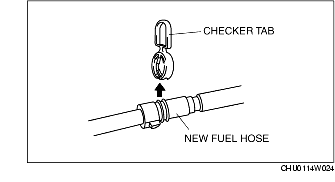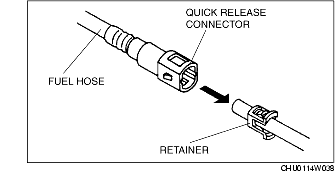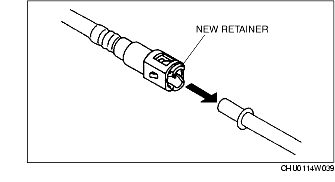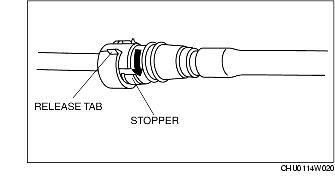QUICK RELEASE CONNECTOR REMOVAL/INSTALLATION
BHE011442692W01
-
Warning
-
• Fuel vapor is hazardous. It can very easily ignite, causing serious injury and damage. Fuel can also irritate skin and eyes. To prevent this, always complete the "Fuel Line Safety Procedure", while referring to the "BEFORE SERVICE PRECAUTIONS".
Inside the Engine Compartment
Removal
1. Follow the before repair procedure and perform the fuel line safety procedure. (See BEFORE REPAIR PROCEDURE.)
-
Caution
-
• The quick release connector may be damaged if the release tab is bent excessively. Do not expand the release tab over the stopper.
-
Note
-
• The hose can be removed by pushing it to the pipe side to release the lock.
2. Rotate the quick release connector release tab to the stopper position.
3. Pull out the fuel hose straight from the fuel pipe and disconnect it.
4. Cover the disconnected quick release connector and fuel pipe with vinyl sheeting or a similar material to prevent it from being scratched or contaminated with foreign material.
-
Note
-
• Take care not to damage or soil the fuel hose.
Installation
-
Note
-
• If the quick release connector O-ring is damaged or has slipped, replace the fuel hose.
-
• A checker tab is integrated with the quick release connector for all of the new fuel hoses and evaporater hoses except for the fuel suction pipe. The checker tab will be released from the quick release connector after it is completely engaged with the fuel pipe.

1. Inspect the fuel hose and fuel pipe sealing surface for damage and deformation.
-
• If there is any malfunction, replace a new part.
2. Apply a small amount of clean engine oil to the sealing surface of the fuel pipe.
3. Reconnect the fuel hose straight to the fuel pipe until a click is heard.
-
Note
-
• If the quick release connector does not move at all, disconnect it and verify that the O-ring is not damaged or has not slipped, then reconnect the quick release connector.
4. Lightly pull and push the quick release connector a few times by hand and verify that it can move (2-3 mm {0.08-0.12 in}) and it is connected securely.
5. Inspect all parts by performing the "AFTER REPAIR PROCEDURE". (See AFTER REPAIR PROCEDURE.)
Fuel Tank Side (Except for Fuel Shut-off/Rollover Valve)
Removal
1. Follow the before repair procedure and perform the fuel line safety procedure. (See BEFORE REPAIR PROCEDURE.)
-
Caution
-
• The quick release connector may be damaged if the release tab is bent excessively. Do not expand the release tab over the stopper.
-
Note
-
• The fuel hose may be removed easily by rotating the release tab while the fuel hose is slightly pressed to fuel pipe side.
2. Rotate the quick release connector release tab to the stopper position.
3. Pull out the fuel hose straight from the fuel pipe and disconnect it.
4. Cover the disconnected quick release connector and fuel pipe with vinyl sheeting or a similar material to prevent it from being scratched or contaminated with foreign material.
-
Note
-
• Take care not to damage or soil the fuel hose.
Installation
-
Note
-
• If the quick release connector O-ring is damaged or has slipped, replace a new fuel hose.
-
• A checker tab is integrated with the quick release connector for all of the new fuel hoses and evaporater hoses except for the fuel suction pipe. The checker tab will be released from the quick release connector after it is completely engaged with the fuel pipe.
Fuel pump pressure hose
1. Inspect the fuel hose and fuel pipe sealing surface for damage and deformation.
-
• If there is any malfunction, replace it with a new part.
2. Apply a small amount of clean engine oil to the sealing surface of the fuel pipe.
3. Reconnect the fuel hose straight to the fuel pipe until a click is heard.
-
Note
-
• If the quick release connector does not move at all, disconnect it and verify that the O-ring is not damaged or has not slipped, then reconnect the quick release connector.
4. Lightly pull and push the quick release connector a few times by hand and verify that it can move (2-3 mm {0.08-0.12 in}) and it is connected securely.
5. Inspect all parts by performing the "AFTER REPAIR PROCEDURE". (See AFTER REPAIR PROCEDURE.)
Fuel Shut-off Valve
Removal
1. Inspect that the quick release connector joint area is free of foreign materials. Clean as necessary.
2. Squeeze the tabs of the retainer and disconnect the quick release connector.
3. Cover the disconnected quick release connector and fuel pipe to prevent it from being scratched or contaminated with foreign materials.
-
Caution
-
• Removing the retainer from the disconnected fuel pipe will reduce the effectiveness of the retainer. The retainer must be replaced when any of the following applies.
-
1. Retainer has been removed.
-
2. Scratches or damage is observed on the retainer.
-
3. Plastic fuel hose has been replaced.
-
4. Fuel filter (high-pressure) has been replaced.
4. If removal of the retainer is required, remove it in the following procedure.
-
Caution
-
• Removing the retainer by using a tool can damage the fuel pipe and cause fuel leakage. Remove the retainer by opening the tabs outward by hand.
-
1. Open the tabs of the retainer outward.
-
2. Remove and discard the retainer.
Installation
1. When the retainer is not removed, perform the following procedure.
-
1. Inspect the plastic fuel hose for kinks. Replace if necessary.
-
2. Inspect that the inside of the fuel pipe and the quick release connector is free of foreign materials and damage. Clean as necessary, taking care not to damage the sealing surfaces.
-
3. Align the fuel pipe and quick release connector so that the tabs of the retainer are correctly fitted into the quick release connector. Push the quick release connector into the retainer until a click is heard.

-
4. Pull the quick release connector by hand and verify that it is installed securely. Visually inspect that the tabs of the retainer are securely fitted into the quick release connector.
2. When the retainer is removed, perform the following procedure.
-
Note
-
• Use the designated genuine retainer only.
-
1. Install a new retainer onto the quick release connector. Visually inspect that the tabs of the retainer are securely fitted into the quick release connector.
-
2. Inspect that the inside of the fuel pipe and the quick release connector is free of foreign materials and damage. Clean as necessary, taking care not to damage the sealing surfaces.
-
3. Push the quick release connector into the fuel pipe until a click is heard.

-
4. Pull the quick release connector by hand and verify that it is installed securely.
Rollover Valve
Removal
1. Squeeze the tabs on the quick release connector and disconnect the fuel hose from the fuel pipe.
2. Cover the disconnected quick release connector and fuel pipe with vinyl sheeting or a similar material to prevent it from being scratched or contaminated with foreign material.
-
Note
-
• Take care not to damage or soil the fuel hose.
Installation
-
Note
-
• A checker tab is integrated with the quick release connector for new fuel hoses.
-
• The checker tab will be released from the quick release connector after it is completely engaged with the fuel pipe.
1. Inspect the fuel hose and fuel pipe sealing surface for damage and deformation, and replace as necessary.
-
• If the quick release connector O-ring is damaged or has slipped, replace a new fuel hose.
2. Push the quick release connector into the fuel pipe until a click is heard.
3. Pull the quick release connector by hand and verify that it is installed securely.



